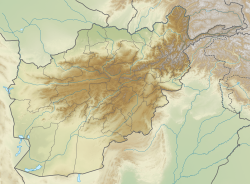Baghlan facts for kids
Quick facts for kids
Baghlan
بغلان
|
|
|---|---|
| Country | |
| Province | Baghlan Province |
| Elevation | 1,732 ft (528 m) |
| Population
(2006)
|
|
| • Total | 119,607 |
| Time zone | + 4.30 |
| Postal code |
36XX
|
Baghlan (which means "temple" or "idol-temple" in Pashto and Dari) is a city in northern Afghanistan. It is located in the Baghlan Province, which is named after it. The city sits about three miles east of the Kunduz River. It is also about 35 miles south of Khanabad. Baghlan is located about 500 meters (1,640 feet) above sea level in the northern Hindu Kush mountains.
The capital of Baghlan Province is actually Pul-e-Khumri. This city is an important center for trade and business. It connects to eight other provinces through the main highway that goes from Kabul to the north.
Contents
History of Baghlan
How Baghlan Grew as a City
Baghlan started to become a bigger city in the 1930s. This happened because a new road was built from Kabul that crossed the Kunduz River. This road made it easier for people and goods to travel to and from Baghlan.
Changing Capitals: Baghlan to Pul-e-Khumri
Before 1964, Baghlan was the capital of a larger area called Qataghan Province. This province no longer exists today.
Later, the capital of Baghlan Province was officially moved from Baghlan city to Pul-e-Khumri. This change happened in the 1980s. A powerful leader named Sayed Mansur Naderi helped make this happen. He had a lot of influence in the military and politics at that time.
The main reason for moving the capital was to make it easier for people to reach government offices. Pul-e-Khumri was a better choice because it is located right on the main highway that connects Kabul to Mazar. This made it a more central and accessible place for everyone.
The government of Dr. Najibullah first suggested this move in March 1989. It was then made official by a special order from Dr. Najibullah a few days later.
Baghlan's Weather Patterns
Baghlan has a type of weather called a cold semi-arid climate. This means it's usually dry, but not a desert, and it can get quite cold.
The average temperature in Baghlan throughout the year is about 15.8°C (60.4°F). The city gets about 284 millimeters (11.2 inches) of rain each year.
July is the warmest month, with an average temperature of 28.3°C (82.9°F). January is the coldest month, with an average temperature of 3.0°C (37.4°F).
| Climate data for Baghlan | |||||||||||||
|---|---|---|---|---|---|---|---|---|---|---|---|---|---|
| Month | Jan | Feb | Mar | Apr | May | Jun | Jul | Aug | Sep | Oct | Nov | Dec | Year |
| Mean daily maximum °C (°F) | 8.3 (46.9) |
10.9 (51.6) |
16.1 (61.0) |
22.1 (71.8) |
29.1 (84.4) |
35.6 (96.1) |
37.4 (99.3) |
36.2 (97.2) |
31.8 (89.2) |
24.8 (76.6) |
15.4 (59.7) |
9.4 (48.9) |
23.1 (73.6) |
| Daily mean °C (°F) | 3.0 (37.4) |
5.7 (42.3) |
10.7 (51.3) |
16.2 (61.2) |
21.5 (70.7) |
26.3 (79.3) |
28.3 (82.9) |
26.6 (79.9) |
22.2 (72.0) |
16.2 (61.2) |
8.7 (47.7) |
4.0 (39.2) |
15.8 (60.4) |
| Mean daily minimum °C (°F) | −2.2 (28.0) |
0.5 (32.9) |
5.4 (41.7) |
10.3 (50.5) |
13.9 (57.0) |
17.1 (62.8) |
19.2 (66.6) |
17.0 (62.6) |
12.6 (54.7) |
7.7 (45.9) |
2.1 (35.8) |
−1.3 (29.7) |
8.5 (47.4) |
| Source: Climate-Data.org | |||||||||||||
What Baghlan Produces
Baghlan is very important for Afghanistan's economy. It is the main place where sugar beet is grown. Sugar beet is a plant used to make sugar.
Growing cotton is also a big part of the economy in this area. Cotton is used to make clothes and other fabric items. Many people in Baghlan work in farming or in factories that process cotton.
Who Lives in Baghlan?
The number of people living in Baghlan has changed a lot over the years. In 1960, about 20,000 people lived there. By 1963, the population grew to about 24,410. Just two years later, in 1965, it was estimated to be around 92,432!
In 2011, it was estimated that about 146,000 people lived in the city areas. Another 616,500 people lived in the surrounding rural areas. Baghlan is home to many different groups of people. The main ethnic groups include Tajiks, Pashtuns, Hazaras, and Uzbeks, along with others.
See also
- In Spanish: Baġlān para niños


